
Back to selection

Supplier
Space Systems/Loral (SS/L)
Space Systems/Loral, Inc.
3825 Fabian Way
CA 94303 Palo Alto
USA
Space Systems/Loral (SS/L) designed and built satellites and space systems for government and commercial customers. Its products included high-powered direct-to-home broadcast satellites, commercial weather satellites, digital audio radio satellites, Earth observation satellites and spot-beam satellites for data networking applications.
Space Systems/Loral (SS/L) parent company, Loral Space & Communications sold SS/L in 2012 to Canadian aerospace company MacDonald Dettwiler and Associates (MDA), making MDA one of the world’s leading communication satellite companies. After the acquisition of Digital Globe in 2017, MDA changed name into Maxar Technologies, headquartered in the USA, with the original MDA kept as a Canadian subsidiary.
On December 30th 2019 Maxar Technologies announced that it would sell its Canadian subsidiary to private equity firms, led by Northern Private Capital, a Toronto-based private investment firm, turning it into a standalone company while providing Maxar with much-needed debt relief.
SS/L’s customers included AsiaSat, Broadcasting Satellite System Corporation, Bulgaria Sat (Bulsatcom), DirecTV, EchoStar (USA), Eutelsat (France), Globalstar, Google’s Skybox Imaging, Hispasat (Spain), Hughes Network Systems, ICO Global Communications, Intelsat (USA), Japan MTSAT, JSC Gascom, Loral Skynet (Telesat Canada), NASA/NOAA (GOES), nbn, Optus (SingTel, Australia), PanAmSat (Intelsat), Pasifik Satelit Nusantara (PSN), QuetzSat, Satmex (Eutelsat), SES S.A, Shin Satellite (ChinaSat), SingTel (Singapore), Sirius Satellite Radio, SKY Perfect JSAT Corporation (Japan), Spainsat, Star One (Brazil), Telenor (Norway), Telesat Canada, Thaicom, ViaSat, WildBlue, and XM Satellite Radio.
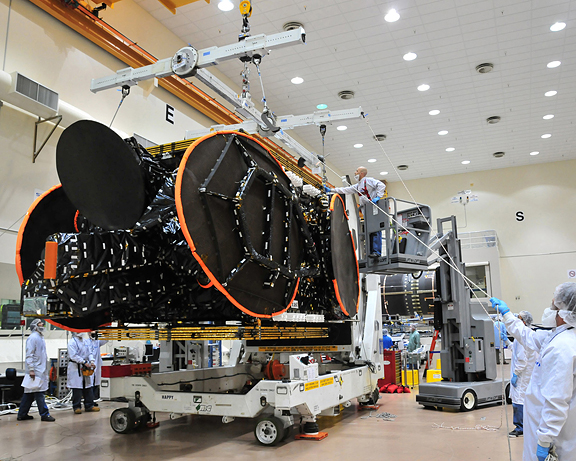
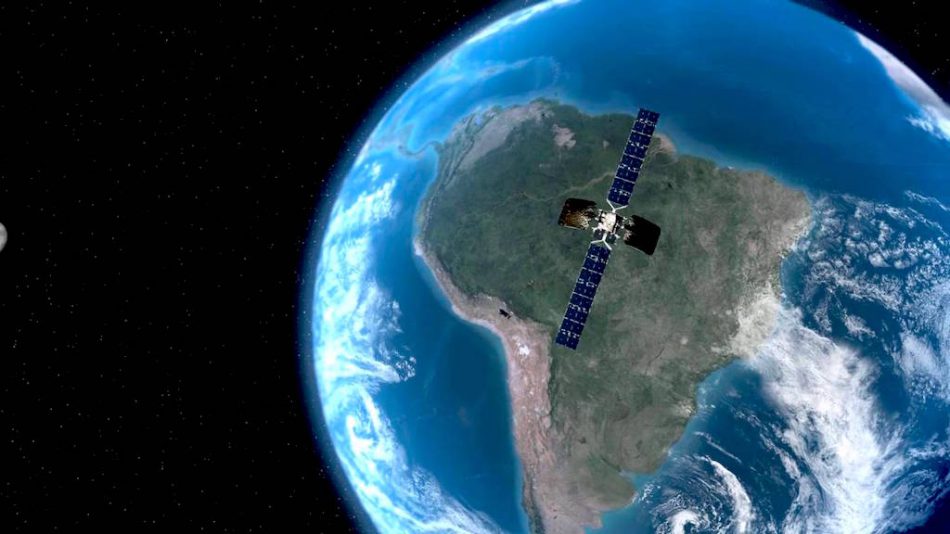
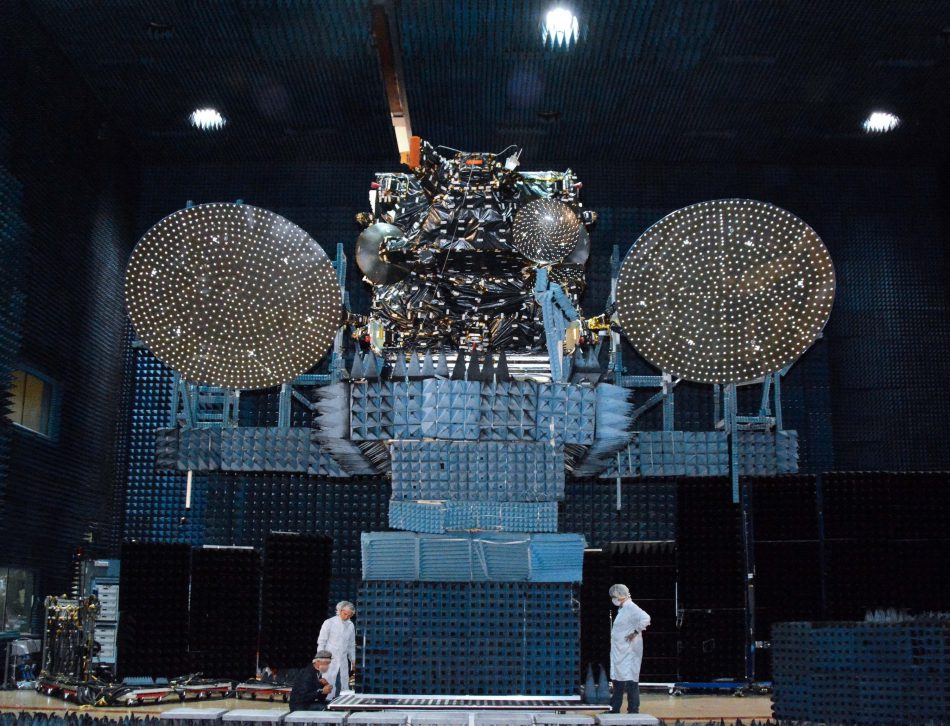
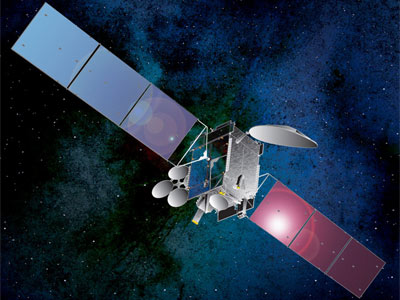
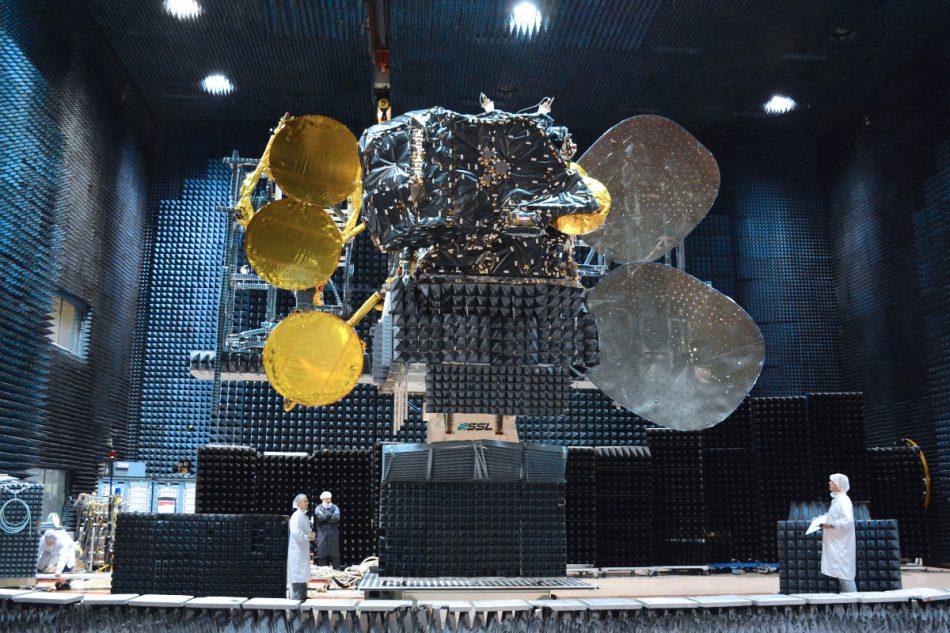
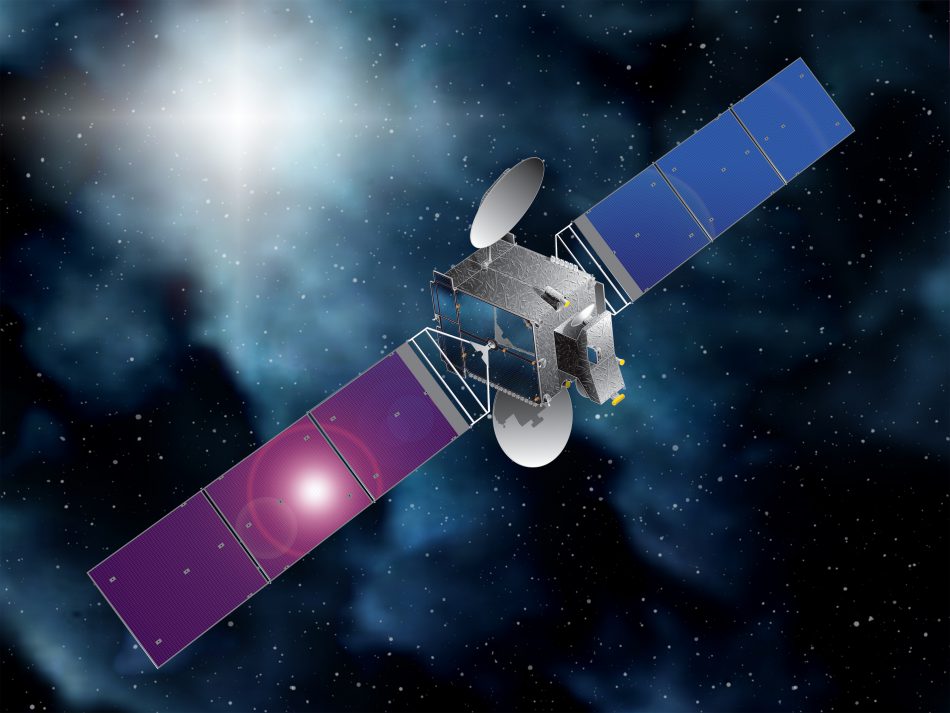
In 1960, the Courier 1B, built by then Philco, became the world’s first active repeater satellite.
Space Systems/Loral (SS/L) had pioneered research in electric propulsion systems, lithium-ion power systems and the use of advanced composites on commercial satellites, which permit significant increases in the size and power of a satellite’s payload and extends the satellite’s on-orbit lifetime. SSL also has developed new service-enhancing technologies such as super power systems for direct-to-user applications and ground-based beam forming, a technology that uses both satellite and terrestrial assets to provide mobile users with increased coverage and capacity capabilities.
Space Systems/Loral (SS/L) major competitors are Boeing, Lockheed Martin, Thales Alenia Space, Airbus Defense & Space and JSC Information Satellite Systems (ISS Reshetnev). As of September 2015, there are 80 SS/L-built GEO satellites currently in orbit.
Company History
Parent company Loral Corporation was a defense contractor and founded in 1948 in New York by William Lorenz and Leon Alpert as Loral Electronics Corporation. The company’s name was taken from the first letters of each founder’s surname.
In 1959 Loral began to diversify and specialized in radar and infrared detection equipment, as well as satellite communications.
Radar and sonar detection methods played an important role during World War II, and the young firm concentrated its efforts in this area, winning contracts for advanced airborne radar systems and U.S. Navy navigation computing. The company bought several smaller companies included Willor Manufacturing Corp., American Beryllium Co., Inc., Arco Electronics, and several plastics companies.
In 1961 Loral formed a division for developing communications, telemetry, and space navigation systems for satellites. It also bought American Beryllium Co. Inc., which was one of the largest precision machiners of beryllium, a lightweight, toxic material that could withstand harsh environments. Under Loral it became a contract manufacturer of components for aerospace guidance systems and nuclear reactors. Loral also bought Arco Electronics in 1961, and in 1963 it acquired A&M Instrument Co., Circle Plastics, and Lerner Plastics, a manufacturer of packaging for prescription medicines and other products.
Loral increased its expansion and buying other companies when it borrowed 15 million USD from the Massachusetts Mutual Life Insurance Company in 1965.
In the late 1960’s, the company was awarded many military contracts, including a 3.9 million USD contract for the US Navy contract for Doppler navigation radar in 1965, a 14 million USD contract from General Dynamics for advanced electronics for the US Air Force F-111 aircraft in 1969 and a 3.9 million USD contract for airborne countermeasures for the Phantom RF-4C reconnaissance plane.
By the late 1960’s, Loral specialized in radar receivers, which identified signatures of enemy radar systems on missiles and anti-aircraft guns, however, Loral’s corporate purchases were causing problems for the company. By 1971 it had lost 3 million USD and was sometimes unable to meet its loan payments. Many acquisitions were not profitable and also not in Loral’s primary business. The founders, Lorenz and Alpert, were prepared to sell half their interest in the company.
Loral was on the verge of bankruptcy in 1972 before it was acquired by Bernhard L. Schwartz, who over the course of two decades built it into a major player in the global aerospace and defense industry, acquiring 16 other defense and aerospace companies. Loral had 5.5 billion USD in revenue in 1995.
Space Systems/Loral LLC. was acquired in 1990 for 715 million USD by Loral Corp. from Ford Motor Company as the Aerospace and Defense Systems Division of Ford Aerospace. The company was founded as the Western Development Laboratories (WDL) later Loral WDL and presently Lockheed Martin WDL.
In 1996 Loral sold its defense electronics and system integration businesses to Lockheed Martin; its remaining units became Loral Space & Communications. The following year, several of those former Loral units were spun off by Lockheed Martin to become the core business of L3 Communications.
Loral was accused of transferring technology to China in 1996. The incident arose as a result of an investigation into the launch failure of Intelsat-708 satellite that was built by Space Systems/Loral LLC. (SS/L). In a 2002 agreement with the State Department and Department of Justice the company agreed to pay 20 million USD in fines to settle the matter and to improve its compliance procedures. Schwartz subsequently released a statement accepting “full responsibility for the matter” and portrayed the incident as an error by a single Loral employee.
On October 5th, 2007 Loral Space & Communications Inc. and the Public Pension Investment Board of Canada received the final regulatory approval necessary to complete the acquisition of Telesat from Canadian Phone giant Bell Canada Enterprises, Inc. (BCE Inc.) for CAD $3.25 billion. The acquisition closed on October 31, 2007, with Loral owning 64% of Telesat Canada. At the same time, Telesat merged with Loral Skynet. This resulted in the transfer of all of the assets, i.e. its infrastructure and satellites: Telstar-10 (APSTAR IIR) at 77° E, Telstar-12 at 13° W, Telstar-14 (Estrela do Sul-1) at 63° W, Telstar-18 at 138° E and Telstar-11N that was under construction and was planned to be located at 37° W.
On November 2, 2012, Loral Space & Communications Inc. announced the sale of subsidiary SS/L, to MacDonald Dettwiler (MDA), a USA headquartered Global Communications and Information company.
In 2017 MDA changed name into Maxar Technologies after the acquisition of DigitalGlobe for 2.4 billion USD. MDA was headquartered in the USA, with the original MDA kept as a Canadian subsidiary. DigitalGlobe was the biggest commercial remote sensing company. The acquisition was the biggest deal to date in the ongoing consolidation in the Earth imaging market.
In 2019 Maxar Technologies sold its Canadian subsidiary to private equity firms, led by Northern Private Capital, a Toronto-based private investment firm in a 729 million USD transaction. The sale of MDA reduced Maxar’s overall debt with 1 billion USD.
Key Dates
1948; Loral Electronics Corporation founded.
1959; Loral makes a public stock offering and becomes a public corporation.
1972; Bernhard L. Schwarz acquires Loral after it is on the verge of bankruptcy.
1987; Goodyear Tire and Rubber Company sold Goodyear Aerospace Corporation (GAC) to Loral, which became Loral Defense Systems.
1990; Loral acquires Ford Aerospace, the divisions of which became SS/L and Loral Western Development Labs.
1991; With Qualcomm, Loral begins the Globalstar project, and at the peak owns a 42% share in the company.
1994; Loral acquires IBM’s Federal Systems Division, which becomes Loral Federal Systems.
1995; Loral acquires Paramax, the defense unit of Unisys, for 862 million USD in cash.
1996; Lockheed Martin agreed to purchase the defense electronics and system integration businesses of Loral for 9.1 billion USD. Loral became Loral Space & Communications.
2007; Loral Space & Communications Inc. and the Public Pension Investment Board of Canada acquired Telesat from BCE Inc.
2012; Loral Space & Communications Inc. sells subsidiary SS/L, to MacDonald Dettwiler (MDA), a Global Communications and Information company.
2017; MDA changed name into Maxar Technologies after the acquisition of DigitalGlobe. MDA was headquartered in the USA, with the original MDA kept as a Canadian subsidiary.
2019; Maxar Technologies sold its Canadian subsidiary to private equity firms, led by Northern Private Capital, a Toronto-based private investment firm.
Resources
www.maxar.com
www.sky-brokers.com
www.wikipedia.org
www.investors.maxar.com
www.spacenews.com edition February 24th 2017
www.spacenews.com edition December 30th 2019

Supplier
Space Systems/Loral (SS/L)
Space Systems/Loral, Inc.
3825 Fabian Way
CA 94303 Palo Alto
USA
Satellites manufactured by Space Systems/Loral (SS/L)
| Spacecraft | Country | |||
| ABS-2 (ST-3, KoreaSat-8)GEO | 75° East | Asia Broadcast Satellite (ABS) |  | Communication |
| ABS-4 (MobiSat-1)GEO | 61° East | Asia Broadcast Satellite (ABS) |  | Communication |
| Amazonas-3GEO | 61º West | Hispasat |  | Communication |
| Amazonas-5GEO | 61° West | Hispasat |  | Communication |
| Anik G1GEO | 107° West | Telesat |  | Communication |
| AsiaSat-5GEO | 100.5° East | AsiaSat |  | Communication |
| AsiaSat-6/Thaicom-7GEO | 120° East | AsiaSat |  | Communication |
| AsiaSat-7 (Thaicom-6A)GEO | 105.5° East | AsiaSat |  | Communication |
| AsiaSat-8 (AMOS 7)GEO | 4° West | AsiaSat |  | Communication |
| AsiaSat-9 (Thaicom-7)GEO | 122° E | AsiaSat |  | Communication |
| Azerspace-2/Intelsat-38 (IS-38)GEO | 45° East | Azercosmos |  | Communication |
| BRIsatGEO | 150.5° East | PT Bank Rakyat Indonesia (Persero), Tbk. |  | Communication |
| BSat-4aGEO | 110° East | B-SAT |  | Broadcasting |
| BSat-4bGEO | 110° East | B-SAT |  | Broadcasting |
| BulgariaSat-1GEO | 2° East | Bulgaria Sat |  | Communication |
| DirecTV 5 (AT&T 5, T5, Tempo I)GEO | 110° West | DirecTV (AT&T) |  | Broadcasting |
| DirecTV-10 (AT&T-10, T10)GEO | 103° West | DirecTV (AT&T) |  | Broadcasting |
| DirecTV-12 (AT&T-12, T12)GEO | 103° West | DirecTV (AT&T) |  | Broadcasting |
| DirecTV-8 (AT&T-8, T8)GEO | 119° West | DirecTV (AT&T) |  | Broadcasting |
| DirecTV-9S (AT&T T9S)GEO | 101° West | EchoStar |  | Communication |
| EchoStar IX (Telstar-13, Intelsat Americas 13, Galaxy-23)GEO | 121° West | EchoStar |  | Communication |
| EchoStar VIII (EchoStar 8)GEO | - | DirecTV (AT&T) |  | Broadcasting |
| EchoStar XIV (EchoStar-14)GEO | 119° West | EchoStar |  | Communication |
| EchoStar XIX (Jupiter-2, Spaceway 5)GEO | 97° West | EchoStar |  | Communication |
| EchoStar XV (EchoStar-15)GEO | 62° West | EchoStar |  | Communication |
| EchoStar XVI (EchoStar-16)GEO | 62° West | EchoStar |  | Communication |
| EchoStar XVII (EchoStar-17, Jupiter-1)GEO | 107° West | EchoStar |  | Communication |
| EchoStar XVIII (EchoStar-18, USABSS-41)GEO | 61° West | EchoStar |  | Communication |
| EchoStar XXI (TerreStar-2, EchoStar-21)GEO | 97° West | EchoStar |  | Communication |
| EchoStar XXIII (EchoStar-23)GEO | 68° West | EchoStar |  | Communication |
| EchoStar XXIV (Jupiter-3, EchoStar-24, HNS-95W)GEO | 105° West | EchoStar |  | Communication |
| Es’hail-1 (Eutelsat-25B, Eurobird 2A)GEO | 25,5° East | Es'hailSat |  | Communication |
| Eutelsat 113 West A (SatMex 6)GEO | 113° West | Eutelsat |  | Communication |
| Eutelsat 117 West A (SatMex 8)GEO | 117° West | Eutelsat |  | Communication |
| Eutelsat 65 West AGEO | 65° West | Eutelsat |  | Communication |
| Eutelsat 7CGEO | 7° East | Eutelsat |  | Communication |
| Galaxy-16 (G-16)GEO | 99° West | Intelsat |  | Communication |
| Galaxy-18 (G-18)GEO | 123° West | Intelsat |  | Communication |
| Galaxy-19 (Intelsat Americas 9, IA-9)GEO | 97° West | Intelsat |  | Communication |
| Galaxy-28 (G-28, Intelsat Americas 8, Telstar-8)GEO | 89° West | Intelsat |  | Communication |
| Galaxy-31 (G-31)GEO | 121° West | Intelsat |  | Communication |
| Galaxy-32 (G-32)GEO | 91° West | Intelsat |  | Communication |
| Galaxy-35 (G-35)GEO | 95° West | Intelsat |  | Communication |
| Galaxy-36 (G-36)GEO | 89° West | Intelsat |  | Communication |
| Galaxy-37 (Horizons-4)GEO | 127° West | Intelsat |  | Communication |
| Hispasat 30W-5 (Hispasat-1E)GEO | 30° West | Hispasat |  | Communication |
| Hispasat 30W-6GEO | 30° West | Hispasat |  | Communication |
| ICO G1 (DBSD G1, EchoStar G1)GEO | 93° West | ICO Satellite Management LLC. |  | Communication |
| Intelsat-14 (IS-14, PAS-14)GEO | 45° West | Intelsat |  | Communication |
| Intelsat-17 (IS-17)GEO | 66° East | Intelsat |  | Communication |
| Intelsat-19 (IS-19)GEO | 166° East | Intelsat |  | Communication |
| Intelsat-20 (IS-20)GEO | 69° East | Intelsat |  | Communication |
| Intelsat-25 (IS-25, ProtoStar-1, ChinaSat-8, ZX-8)GEO | 98.5° East | Intelsat |  | Communication |
| Intelsat-30 (IS-30, DLA-1)GEO | 95° West | Intelsat |  | Communication |
| Intelsat-31 (IS-31, DLA-2)GEO | 95° West | Intelsat |  | Communication |
| Intelsat-34 (IS-34, Hispasat 55W-2)GEO | 56° East | Hispasat |  | Communication |
| Intelsat-36 (IS-36)GEO | 68.5° East | Intelsat |  | Communication |
| Intelsat-39 (IS-39)GEO | 62° East | Intelsat |  | Communication |
| Intelsat-40e/TEMPO (IS-40e)GEO | 91° West | Intelsat |  | Communication |
| Intelsat-901 (IS-901) (ext. lifespan with MEV-1)GEO | 332.5° East | Intelsat |  | Communication |
| Intelsat-902 (IS-902)GEO | 310° East (Inclined Orbit) | Intelsat |  | Communication |
| Intelsat-903 (IS-903)GEO | - | Intelsat |  | Broadcasting |
| Intelsat-904 (IS-904)GEO | 29° West | Intelsat |  | Communication |
| Intelsat-905 (IS-905)GEO | 336° East | Intelsat |  | Communication |
| Intelsat-906 (IS-906)GEO | 64° East | Intelsat |  | Communication |
| iPStar (Thaicom-4, MEASAT-5, Synertone-1)GEO | 119.5° East | MEASAT |  | Communication |
| JCSAT-110A (JCSAT-15)GEO | 110° East | SKY Perfect JSAT |  | Communication |
| JCSAT-16GEO | 162° East | SKY Perfect JSAT |  | Communication |
| JCSAT-2b (JCSAT-14)GEO | 154° East | SKY Perfect JSAT |  | Communication |
| Nimiq 5 (EchoStar-72W)GEO | 72° West | EchoStar |  | Communication |
| Nimiq 6GEO | 91° West | Telesat |  | Communication |
| NSS-12GEO | 57° East | SES |  | Communication |
| Nusantara Satu (Nusantara 1 / PSN 6)GEO | 146° East | Pasifik Satelit Nusantara (PSN) |  | Communication |
| Optus 10GEO | 164° East | Optus Australia |  | Communication |
| Ovzon-3MicroGEO | 60° East | Ovzon |  | Communication |
| QuetzSat-1GEO | 77° West | QuetzSat |  | Communication |
| SES-4 (NSS-14)GEO | 22° West | SES |  | Communication |
| SES-5 (Sirius-5, Astra 4B)GEO | 5° East | SES |  | Communication |
| Sirius FM-1 (Radiosat-1)GEO | - | SiriusXM |  | Broadcasting |
| Sirius FM-2 (Radiosat-2)GEO | - | SiriusXM |  | Broadcasting |
| Sirius FM-3 (Radiosat-3)GEO | - | - |  | Broadcasting |
| Sirius FM-5 (Radiosat-5)GEO | 82.2° West | SiriusXM |  | Broadcasting |
| Sirius FM-6 (Radiosat-6)GEO | 116° West | SiriusXM |  | Broadcasting |
| Sky Muster I (NBN-Co 1A)GEO | 140° East | NBN Co. Ltd. (NBN) |  | Communication |
| Sky Muster II (NBN-Co 1B)GEO | 145° East | NBN Co. Ltd. (NBN) |  | Communication |
| SpainSat-1 (XTAR-LANT)GEO | 30° West | Hisdesat Servicios Estratégicos S.A. |  | Military & Intelligence |
| Star One C4 (HispaSat 70W-1)GEO | 70° West | Hispasat |  | Communication |
| Star One D1GEO | 84° West | Star One |  | Communication |
| Star One D2GEO | 70° West | Star One |  | Communication |
| SXM-5GEO | 115° West | SiriusXM |  | Broadcasting |
| SXM-7GEO | 85° West | SiriusXM |  | Broadcasting |
| SXM-8GEO | 85° West | SiriusXM |  | Broadcasting |
| SXM-9GEO | 85° West | SiriusXM |  | Broadcasting |
| Telkom-4 (Merah Putih)GEO | 108° East | Telkomsat |  | Communication |
| Telstar 14/Estrela-do-Sul 1 (Southern Star 1)GEO | 63° West | Telesat |  | Communication |
| Telstar-11N (Telstar-11R)GEO | 37.5° West | Telesat |  | Communication |
| Telstar-12 (Orion-2)GEO | 109° West | Telesat |  | Communication |
| Telstar-14R/Estrela do Sul 2GEO | 63° West | Telesat |  | Communication |
| Telstar-18/APSTAR VGEO | 138° East | APT Satellite Co. |  | Communication |
| Telstar-18V (APSTAR-5C)GEO | 138° East | Telesat |  | Communication |
| Telstar-19V (Telstar 19 Vantage)GEO | 63° West | Telesat |  | Communication |
| Telstar-5 (Intelsat Americas 5, Galaxy-25)GEO | 33° East | Intelsat |  | Communication |
| Terrestar-1 (EchoStar-T1, CANSAT-24)GEO | 111.1° West | - |  | Communication |
| THOR 7GEO | 1° West | Space Norway (former Telenor Satellite Services) |  | Communication |
| Viasat-1 (VS-1)GEO | 115° West | Viasat, Inc. |  | Communication |
| Wildblue-1 (KaStar-1, iSky-1, WB-1)GEO | 111° West | Viasat, Inc. |  | Communication |
| XTAR-EURGEO | 29° East | HisdeSat |  | Military & Intelligence |